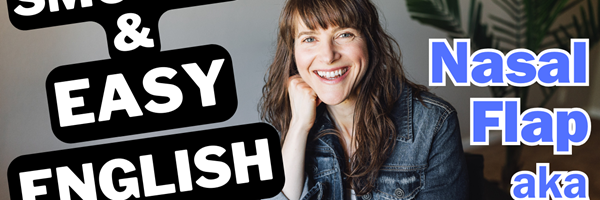(Video Transcript)
The Glottal Stop T in American English
Welcome to the second video of the four-video series about how to speak English with ease. If you haven’t watched the first video on the flap sound, then please watch that video first - you can click here for the link or click the link in the description below.
This four-video series will focus on the T consonant sound and the many ways that the T sound can be pronounced in American English. Why the T sound? Well, in spoken English, the T sound can change to a completely different type of T sound, and the reason for this is to help that word or phrase to be smoother, faster, and more connected. That’s what English wants - it wants to be smooth, and the T sound sometimes gets in the way of this smoothness.
If I use a true T sound,
T,
T,
T
In a word like absolutely,
It sounds a little disconnected between the last two syllables.
Listen again.
Absolutely
Absolutely
Do you hear how I have to use more effort to pronounce that T sound?
Absolutely.
T,
T
T
That’s the true T sound, and the very nature of its pronunciation
T
T
T
Can disrupt the flow of speech.
So what do native speakers use instead of this True T sound?
The glottal stop T.
Absolutely
Absolutely
Ahh, that’s much smoother between the last two syllables, right?
Listen to the two words side by side. The first time I say it, I’ll use the true T sound,
T
T
T
The second time I say it, I’ll use the glottal stop T.
absoluTely
Absolutely
You should have heard that the second pronunciation, the one with the glottal stop T, was smoother, faster, and more connected.
And that’s what native speakers are using to make their spoken English sound easy and effortless. They’re not usually using a true T here. Instead, they’re using a glottal stop T.
What is the Glottal Stop T? How do you pronounce the Glottal Stop T?
So what is this glottal stop T and when do you use it?
The glottal stop T is made in the throat with the vocal cords. It’s the same movement that you feel when you cough or clear your throat,
Ahem!
You should feel like something is moving in your throat when you cough. That movement is from the vocal cords, closing together to create pressure.
That’s the same feeling of the glottal stop T. It’s a T sound made with the vocal cords as they close together.
If you’re making the glottal stop T correctly, you should not be able to breathe or talk at the same time because the vocal cords are sealed shut, and nothing is coming out of your throat or mouth.
Absolutely
Did you hear that abrupt end of the third syllable, “loot”?
Loot
Loot
Loot
It has to be abrupt and crisp. That signals a T sound in English. So the T sound isn’t missing from this word; it’s just a different type of T sound, called a glottal stop T, and it’s made with the vocal cords.
Just FYI, the glottal stop T is also called the stop T or the glottal stop - I use all three terms interchangeably to mean the same sound.
Ok, so now you know what native speakers are doing to make certain words and phrases smoother. They’re pronouncing the T sound like a glottal stop T.
When to Use the Glottal Stop T in American English
But when do you use the glottal stop T?
When T comes at the end of a syllable or word, and links up with a consonant, then the T usually becomes a glottal stop T.
Look at the IPA of absolutely, and I’ll change the transcription back to a /t/ consonant. See how the syllable “loot” ends with a T consonant, and it links up with the L consonant? Final T to a consonant equals a glottal stop T.
Absolutely
This happens in many words, like absolutely, and when linking words together, like “take it down”. You have to pay attention to where the T occurs in the word and what it links up with - that’s how you’ll know if it changes to a glottal stop T.
Another cool thing about the glottal stop T is it also occurs in words like
Button
Forgotten
And certain
Here, the rule is if T comes between vowels, and the T is unstressed, and the end of the unstressed syllable has an N consonant, then the T turns into a glottal stop T and the vowel is dropped from the pronunciation.
I know that was a lot of information, but let’s break down this rule step by step. We’ll use the word button, and I’ll put the /t/ consonant back into the IPA.
The IPA of the word button, when pronounced with the true T consonant, looks like this. But when this word is spoken, the way it links is like this.
You’ll see that the T moves over to the beginning of the next syllable, and it sounds like:
Buh-tin
Not, but-in
Buh-tin - that’s how it links.
Now you can see that the T is between vowels, and it comes at the beginning of an unstressed syllable, “tin”. This unstressed syllable also ends with the N consonant.
Now you can change the T to a glottal stop and drop the next vowel, which sounds like:
BUT-n.
That’s how this word is typically pronounced, using a glottal stop T and dropping the vowel.
BUT-n, not BU-tin
Can you hear how the glottal stop T pronunciation is smoother and faster?
Listen to these speakers use the glottal stop T, and pay attention because it happens really quickly.
Speak Like a Native: Glottal Stop T Practice
Let’s practice a few words and phrases that contain the glottal stop T, up close and in slow motion. You’ll hear each word or phrase three times to help train your ears to hear the glottal stop T, then you’ll have a chance to imitate in the pauses.
5 words:
Atmosphere
Nightmare
Outside
Limitless
eaten
3 phrases:
I want a hot dog.
Put this down.
It can’t be.
Glottal Stop T Practice: English Pro
Looking for more glottal stop T practice? I’ve got you covered! You can practice the glottal stop T with me in English Pro, my comprehensive online American accent training program, where you’ll have access to hundreds of practice videos and audio recordings that practice the glottal stop T sound in words, phrases, and sentences. Check out the description below for the link to learn more about English Pro, and how we can work together during a live English class.
Or if you want to practice the glottal stop T now, then become a member of my YouTube channel by clicking the Join button below. All members have immediate access to practice videos that are exclusive to members of my YouTube channel, and you can start practicing right now. This is a great way to support my channel, and it helps me to continue providing you with awesome, free English pronunciation lessons. So click on the Join button below and select the membership level that’s best for you.
If you like this video and found it helpful, then please click the like button and subscribe to my channel with notifications turned, so you don’t miss any of my free English lessons. This really helps other people to find me in the giant world of YouTube.
Thanks so much for watching, and I hope you have a great day!



